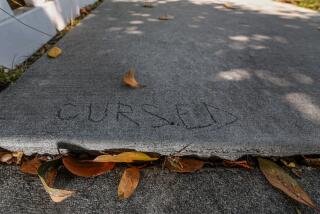Opinion: Angelenos are dying while angry motorists are torching L.A.âs street safety plans. Where is Mayor Garcetti?
With each passing year, Los Angelesâ transportation system seems to bear an increasing resemblance to the dystopian film series âThe Hunger Games.â We accept as tributes the deaths of hundreds of our children, our family members and our neighbors in traffic collisions â sacrificed to the nostalgic fantasy of a conveniently drivable city.
In 2015, it seemed like an end to this horrific reality was finally nearing. Mayor Eric Garcetti issued an executive order enacting a program called Vision Zero, vowing to eliminate deadly collisions on city streets by 2025. L.A.âs program was to be modeled after one that succeeded over decades in Sweden, and had achieved a 27% reduction in deaths after just three years in New York City. The program worked by acknowledging that people will inevitably make mistakes, but that by redesigning roads to deter speeding, those mistakes donât have to be deadly.
And yet, since the mayorâs 2015 directive, Los Angeles hasnât just gotten more dangerous, it has become outright hostile to the concept of roadway safety. A small but vocal contingent of residents has taken an increasingly combative posture to any meaningful safety improvements that appear to interfere with their daily car commutes. City agencies have responded to this pushback by buckling â either canceling or watering down proposals to address dangerous speeding on North Figueroa Street, Lankershim Boulevard, the Hyperion bridge and elsewhere. At the same time, weâve seen a 43% increase in traffic fatalities in the first year after the adoption of Vision Zero, with the fatality rate trending to rise again in 2017.
Garcetti, meanwhile, has been inexplicably and unaccountably silent on the matter.
When Councilman Mike Bonin and Garcetti announced last week that they were removing a multi-street Vision Zero effort in Playa del Rey, it was in large part because Garcetti refused to insert himself in the debate around safety. As the drama escalated and some residents threatened a recall of Bonin over the safety upgrades, Garcetti never came to the councilmanâs defense. Confused motorists who were upset that the city seemed to be worsening their driving commutes received no explanation from the mayor that, in fact, the city was acting to curb multimillion-dollar settlements for frequent pedestrian deaths that courts had deemed to be preventable.
L.A.âs Vision Zero failures belong first to Angelenos who are obstructing the program out of anger over traffic congestion that would work itself out over time, and which data show is actually much less severe than most drivers perceive. But the mayor isnât powerless here. In 2016 he successfully lobbied Angelenos to tax themselves to provide billions for transportation funding via Measure M. So why isnât he using his bully pulpit to speak up now for Vision Zero?
This inaction is especially perplexing considering Garcetti is just beginning an extended 5½ year term, plenty of time to implement transformative changes and allow them to settle in before facing another election. Why would Angelenos entrust Garcetti with higher office when he has been unable to deliver on his own policy goals locally?
The failure of leadership is alarming. If L.A. canât get behind even modest changes that could affect rush hour drive times to save lives, how can we expect to do so in order to improve public transit, support new housing, or to achieve the mayorâs vision for the 2028 Olympics?
New York Cityâs former Transportation Commissioner Janette Sadik-Khan credits the unwavering support she received from New York City Mayor Mike Bloomberg as crucial to overcoming driver backlash in her successful efforts to remake her cityâs streets between 2007 and 2013. As she wrote in her 2016 book âStreet Fightâ: âFor leaders, overcoming obsolete thinking demands the resolve, courage, and grit to withstand the slings and arrows that inevitably follow change.â
Angelenos admonish national leaders for failing to address climate change while locally we attack improvements to sustainable transportation options for fear of losing some personal convenience. Many are upset at congressional leaders who fail to hold the executive branch to account, yet we have let our mayor and City Council off the hook for their lack of leadership. Should we be surprised when our representatives select political expediency over moral courage?
If Mayor Garcetti doesnât have the backbone to improve the safety of L.A.âs streets, will Angelenos find the courage to demand that he grow one?
Michael MacDonald is a Los Angeles-based architect and advocate for safe streets.
Follow the Opinion section on Twitter @latimesopinion or Facebook
More to Read
A cure for the common opinion
Get thought-provoking perspectives with our weekly newsletter.
You may occasionally receive promotional content from the Los Angeles Times.










